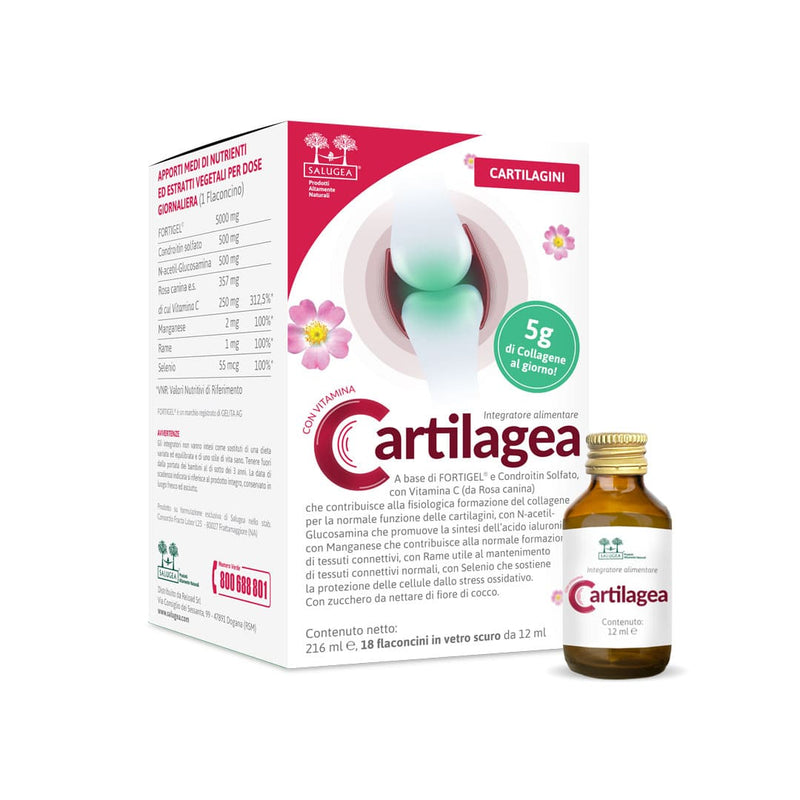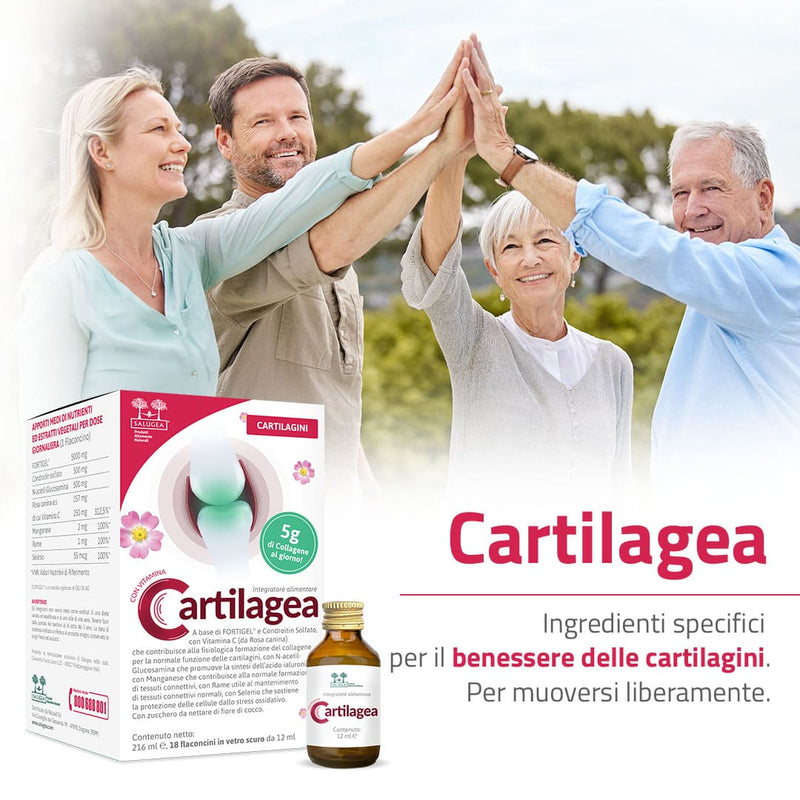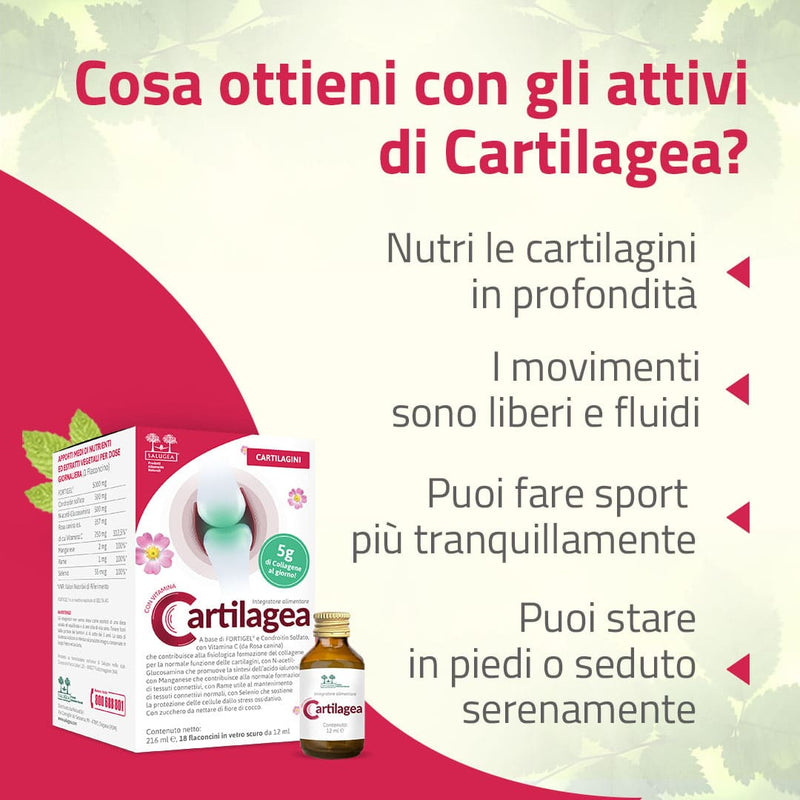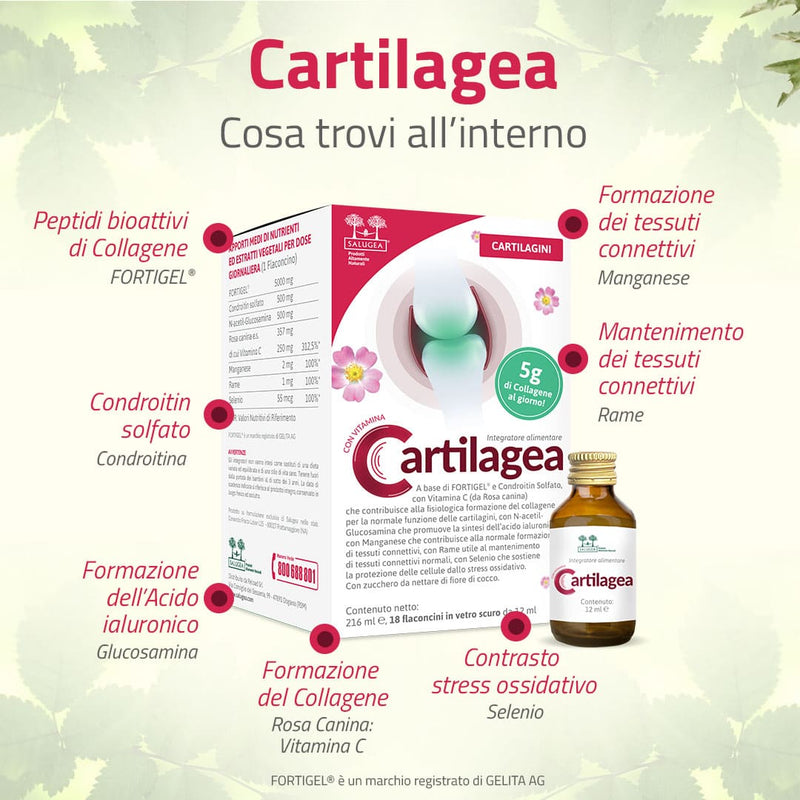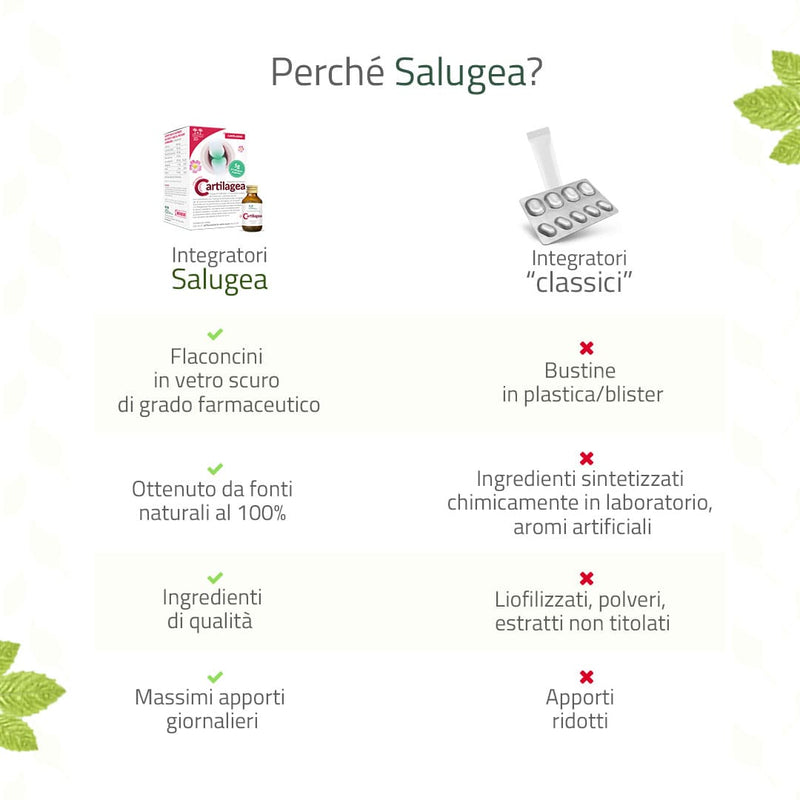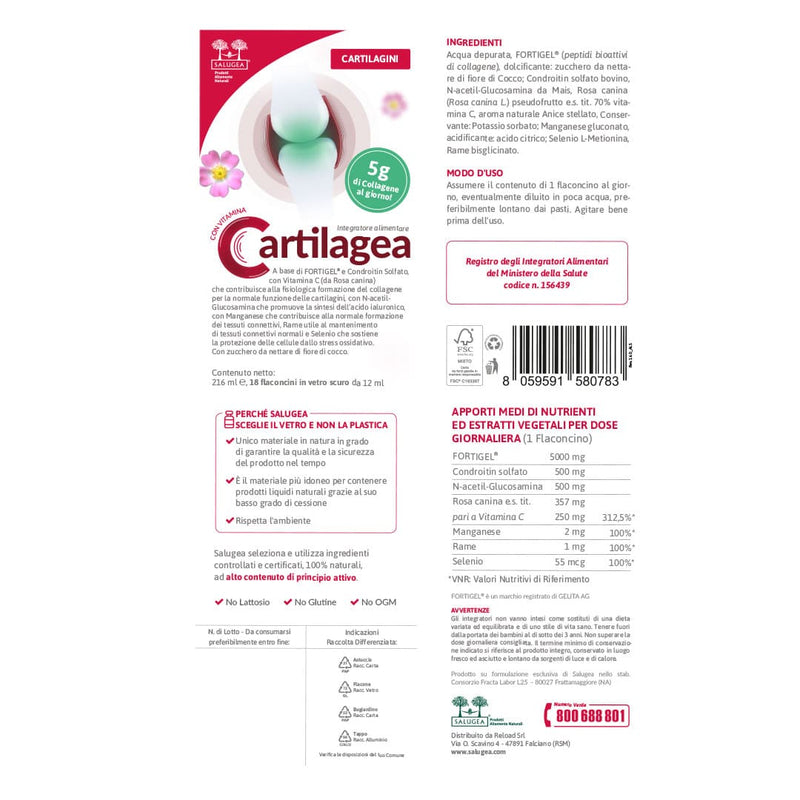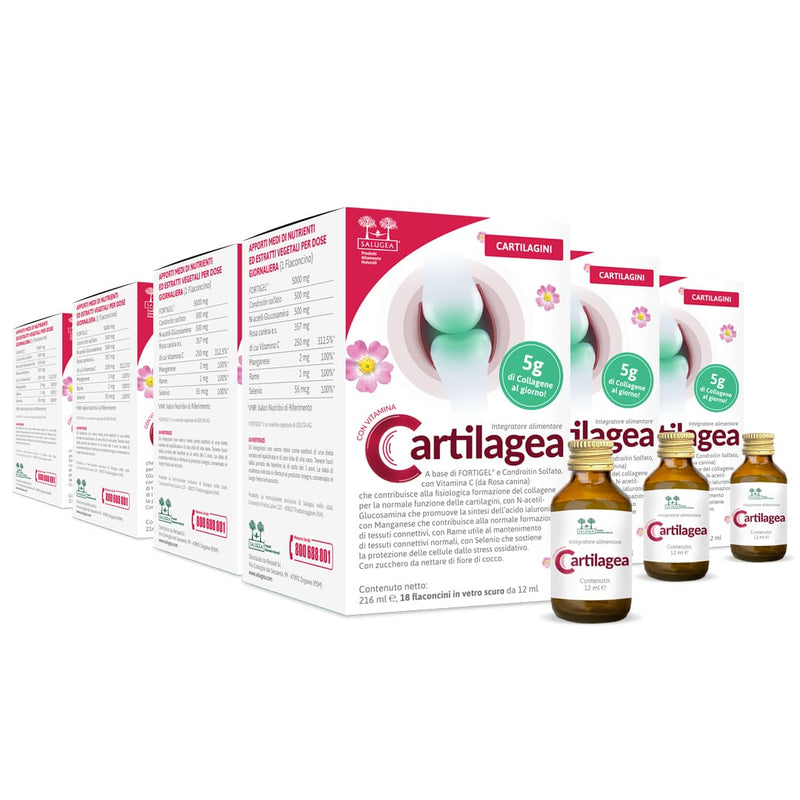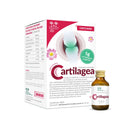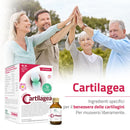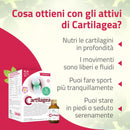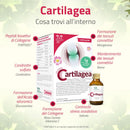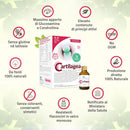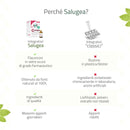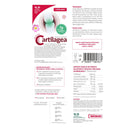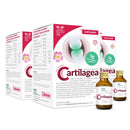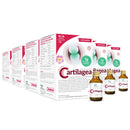Scientific Insights
Cartilage is a strong and flexible connective tissue that protects bones and joints by absorbing shocks and reducing friction during movement.
Cartilage contains metabolically active cells called chondrocytes and various kinds of structural proteins that vary in quantity according to each type of cartilage.
According to the composition of their tissue, cartilages can be of three types.
- Hyaline Cartilage is the most common type of cartilage that is found throughout the body. It lines the joints (articular cartilage), ribs, nose, trachea (windpipe), bronchi and larynx.
- Elastic cartilage is the most flexible cartilage in the body. Its locations in the body are, for instance, external ears (auricles) and epiglottis.
- Fibrocartilage is the strongest and least flexible of the three and is found in the meniscus of the knee, in disks between the spine vertebrae (intervertebral discs) and in pubic symphysis.
Cartilage is therefore a fundamental structure and has a peculiarity that makes it unique in the body: it is not vascularized (i.e. it has no blood vessels).
This characteristic entails that it is difficult for the cartilage to get nutrients and, at the same time, to get rid of toxins that tend to build up.
Another characteristic of the cartilage is that 65 to 80% of its weight is water.
Usually, cartilage problems appear after the age of 40 and are mainly due to wear and tear.
Articular cartilage injuries are often associated with other joint conditions. A study[1] on 200 cases showed that only 6.5% presented a single lesion, whilst 61.5% had multiple lesions.
Other similar structures at the joint level, which are also subjected to extreme stress, include tendons and ligament - fibrous connective elements composed of collagen and elastin.
Regenerative processes in tendons and ligaments are also very slow because these tissues are poorly vascularized and have a relatively low oxygen consumption. As a result, they are easily prone to injuries and micro-injuries caused by excessive effort or repeated strain (e.g., the Achilles tendon in runners, or tennis elbow in tennis players).
Natural remedies can do a great deal to support cartilage, tendons, and ligaments, and help people maintain a good quality of life by preserving their joints full functionality.
Let's see now what are the natural ingredients that have been included in Cartilagea based on scientific evidence.
Experimental Phytotherapy
FORTIGEL®
Clark KL et Al. 24-Week study on the use of collagen hydrolysate as a dietary supplement in athletes with activity-related joint pain. Curr Med Res Opin. 2008 May;24(5):1485-96. doi: 10.1185/030079908x291967. Epub 2008 Apr 15. PMID: 18416885.
This clinical study conducted at Penn State University (USA), involved 147 athletes experiencing activity-related joint pain. Athletes (aged 20.1 years on average) were divided into two groups. Over a period of 24 weeks, one group was administered FORTIGEL® (a dietary supplement), while the control group was administered a placebo. The severity of symptoms was assessed by both the treating physician and the athletes by means of an analog judgment scale. At the end of the 24-week treatment, athletes on FORTIGEL® showed an improvement on the symptomatology scale.
The study confirms that FORTIGEL® collagen hydrolysate administered to athletes can reduce discomfort (such as pain) thus improving their athletic performance.
McAlindon TE, Nuite M, Krishnan N, Ruthazer R, Price LL, Burstein D, Griffith J, Flechsenhar K. Change in knee osteoarthritis cartilage detected by delayed gadolinium enhanced magnetic resonance imaging following treatment with collagen hydrolysate: a pilot randomized controlled trial. Osteoarthritis Cartilage. 2011 Apr;19(4):399-405. doi: 10.1016/j.joca.2011.01.001. Epub 2011 Jan 18. PMID: 21251991.
The clinical study investigated FORTIGEL® long-term effects on the composition of hyaline cartilage, in individuals with early-stage knee osteoarthritis. Monitoring was carried out by MRI (magnetic resonance imaging) analysis of the cartilage. At the end of the study, subjects treated with FORTIGEL® - unlike the placebo group - showed a statistically significant increase in the density of proteoglycans in the medial and lateral tibial regions, which resulted in improved knee functions.
Chondroitin
Martel-Pelletier J, Kwan Tat S, Pelletier JP. Effects of chondroitin sulfate in the pathophysiology of the osteoarthritic joint: a narrative review. Osteoarthritis Cartilage. 2010 Jun;18 Suppl 1:S7-11. doi: 10.1016/j.joca.2010.01.015. Epub 2010 Apr 27. PMID: 20399897.
This review summarizes some data relating to the mechanisms of action of chondroitin sulfate in the pathophysiology of osteoarthritic joint tissues. Researchers suggest that chondroitin mechanism of action stimulates the chondrocytes synthesis of proteoglycans and decreases their catabolic activity by inhibiting the synthesis of proteolytic enzymes and other factors that contribute to the cartilage matrix damage and cause the chondrocytes death. Chondroitin sulfate has also been shown to exert a remarkable anti-inflammatory activity.
Wildi LM, Raynauld JP, Martel-Pelletier J, Beaulieu A, Bessette L, Morin F, Abram F, Dorais M, Pelletier JP. Chondroitin sulphate reduces both cartilage volume loss and bone marrow lesions in knee osteoarthritis patients starting as early as 6 months after initiation of therapy: a randomized, double-blind, placebo-controlled pilot study using MRI. Ann Rheum Dis. 2011 Jun;70(6):982-9. doi: 10.1136/ard.2010.140848. Epub 2011 Mar 1. PMID: 21367761; PMCID: PMC3086081.
The objective of the study was to determine the effect of chondroitin sulphate treatment on cartilage volume loss in patients with knee osteoarthritis. The six-month double-blind study involved 69 patients with clinical signs of synovitis. Cartilage volume was assessed by MRI (Magnetic Resonance Imaging). At the end of the research, the chondroitin sulphate group showed significantly less cartilage volume loss than the placebo group. These findings suggest that chondroitin sulphate has a protective effect on the joint structure of the knee affected by osteoarthritis which can be therefore successfully treated.
Glucosamine
Shikhman AR, Brinson DC, Valbracht J, Lotz MK. Differential metabolic effects of glucosamine and N-acetylglucosamine in human articular chondrocytes. Osteoarthritis Cartilage. 2009 Aug;17(8):1022-8. doi: 10.1016/j.joca.2009.03.004. Epub 2009 Mar 24. PMID: 19332174; PMCID: PMC2785807.
This study analyzes the metabolic effects of Glucosamine on articular chondrocytes in the knee cartilage. The results show that chondrocytes absorb Glucosamine which is used for the production of new hyaluronic acid. The increased synthesis of hyaluronic acid accelerated by Acetyl-Glucosamine is associated with the upregulation of the enzyme hyaluronan synthase-2, which confirms the functional action of this element.
Gallagher B, Tjoumakaris FP, Harwood MI, Good RP, Ciccotti MG, Freedman KB. Chondroprotection and the prevention of osteoarthritis progression of the knee: a systematic review of treatment agents. Am J Sports Med. 2015 Mar;43(3):734-44. doi: 10.1177/0363546514533777. Epub 2014 May 27. PMID: 24866892.
This work shows how the combined use of glucosamine and chondroitin sulfate is an effective non-surgical way to preserve the articular cartilage of the knee and delay the progression of osteoarthritis.
Rosehip (Vitamin C)
Sharma G, Saxena RK, Mishra P. Regeneration of static-load-degenerated articular cartilage extracellular matrix by vitamin C supplementation. Cell Tissue Res. 2008 Oct;334(1):111-20. doi: 10.1007/s00441-008-0666-9. Epub 2008 Aug 5. Erratum in: Cell Tissue Res. 2009 May;336(2):347. PMID: 18679720.
This in-vitro study investigated the effect of a physiological dose of vitamin C on chondrocytes. The results show that in-vitro vitamin C supplementation has the potential to reduce the degeneration of chondrocytes, thereby improving the cellular health of articular cartilage.
Chang Z, Huo L, Li P, Wu Y, Zhang P. Ascorbic acid provides protection for human chondrocytes against oxidative stress. Mol Med Rep. 2015 Nov;12(5):7086-92. doi: 10.3892/mmr.2015.4231. Epub 2015 Aug 20. PMID: 26300283.
The study aimed to assess the effects of Vitamin C on human chondrocytes. Evidence showed that ascorbic acid increases the production of collagen and proteins and inhibits the differentiation of chondrocytes under conditions of oxidative stress, thus promoting the preservation of cartilage tissue.
Manganese, Copper and Selenium
Valero G, Alley MR, Badcoe LM, Manktelow BW, Merrall M, Lawes GS. Chondrodystrophy in calves associated with manganese deficiency. N Z Vet J. 1990 Dec;38(4):161-7. doi: 10.1080/00480169.1990.35645. PMID: 16031605.
This study was carried out on calves affected by a severe cartilage malformation (congenital chondrodystrophy). It was found that the feed given to pregnant cows was very low in Manganese, which caused a histological deficiency in the calves’ cartilage.
Pasqualicchio M, Gasperini R, Velo GP, Davies ME. Effects of copper and zinc on proteoglycan metabolism in articular cartilage. Mediators Inflamm. 1996;5(2):95-9. doi: 10.1155/S0962935196000154. PMID: 18475704; PMCID: PMC2365780.
Copper plays a strategic role in the physiological preservation of cartilage. This in-vitro study investigated the effect of Copper and Zinc on the chondroblasts capability of producing proteoglycans, in a porcine articular cartilage. It was observed that Zinc exerts no stimulating action on chondroblasts, whilst Copper does. This finding was supported by the histological demonstration of copper-dependent reversal of the proteoglycan depletion in cartilage.
Kang D, Lee J, Wu C, Guo X, Lee BJ, Chun JS, Kim JH. The role of selenium metabolism and selenoproteins in cartilage homeostasis and arthropathies. Exp Mol Med. 2020 Aug;52(8):1198-1208. doi: 10.1038/s12276-020-0408-y. Epub 2020 Aug 13. PMID: 32788658; PMCID: PMC7423502.
The study investigates the link between Selenium deficiency and selenoproteins dysregulation that are associated with impaired redox homeostasis in cartilage leading to the onset and progression of osteoarthritis, and similar pathological conditions.
Cartilage and tendons
Nutraceuticals containing multiple specific nutrients can be helpful in managing discomfort affecting both cartilage and tendons[2] [3], thanks to the anti-inflammatory effects of some natural ingredients and their support of the body’s natural connective tissue repair processes.
Therefore, supplements composed of, for example, collagen peptides, chondroitin, vitamin C, and similar components may have strong potential as an additional approach alongside standard treatment methods (such as physical exercise or rehabilitation)[4] [5].
DISCLAIMER. The content is not intended to be a substitute for professional medical advice, diagnosis, or treatment. Always seek the advice of your physician or other qualified health provider with any questions you may have regarding your medical condition.
[1] Articular cartilage lesions of the knee. Ronald W. Zamber, M.D. Carol C. Teitz, M.D. David A. McGuire, M.D. John D. Frost, M.D.
[2] Hijlkema A, Roozenboom C, Mensink M, Zwerver J. The impact of nutrition on tendon health and tendinopathy: a systematic review. J Int Soc Sports Nutr. 2022 Aug 3;19(1):474-504. doi: 10.1080/15502783.2022.2104130. PMID: 35937777; PMCID: PMC9354648.
[3] Burton I, McCormack A. Nutritional Supplements in the Clinical Management of Tendinopathy: A Scoping Review. J Sport Rehabil. 2023 May 5;32(5):493-504. doi: 10.1123/jsr.2022-0244. PMID: 37146985.
[4] Choudhary A, Sahu S, Vasudeva A, Sheikh NA, Venkataraman S, Handa G, Wadhwa S, Singh U, Gamanagati S, Yadav SL. Comparing Effectiveness of Combination of Collagen Peptide Type-1, Low Molecular Weight Chondroitin Sulphate, Sodium Hyaluronate, and Vitamin-C Versus Oral Diclofenac Sodium in Achilles Tendinopathy: A Prospective Randomized Control Trial. Cureus. 2021 Nov 19;13(11):e19737. doi: 10.7759/cureus.19737. PMID: 34812335; PMCID: PMC8603329.
[5] Dos Santos DR, Xavier DP, de Ataíde LAP, Bentes LGB, Lemos RS, Giubilei DB, de Barros RSM. The Effects of Hydrolyzed Collagen and Collagen Peptide in the Treatment of Superficial Chondral Lesions: An Experimental Study. Rev Bras Ortop (Sao Paulo). 2022 Oct 20;58(1):72-78. doi: 10.1055/s-0042-1756332. PMID: 36969779; PMCID: PMC10038713.
I nostri testi hanno scopo divulgativo, non vanno intesi come indicazione di diagnosi e cura di stati patologici e non vogliono sostituirsi in alcun modo al parere del Medico.

